

Framework Design Guidelines: Data Source Architectural Patterns. An object that acts as a Gateway (466) to a single record in a data source.
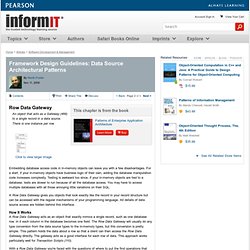
There is one instance per row. Embedding database access code in in-memory objects can leave you with a few disadvantages. For a start, if your in-memory objects have business logic of their own, adding the database manipulation code increases complexity. Testing is awkward too since, if your in-memory objects are tied to a database, tests are slower to run because of all the database access. You may have to access multiple databases with all those annoying little variations on their SQL. A Row Data Gateway gives you objects that look exactly like the record in your record structure but can be accessed with the regular mechanisms of your programming language.
How It Works A Row Data Gateway acts as an object that exactly mimics a single record, such as one database row. It's often hard to tell the difference between a Row Data Gateway and an Active Record (160). When to Use It Example: A Person Record (Java) Inversion of Control Containers and the Dependency Injection pattern. In the Java community there's been a rush of lightweight containers that help to assemble components from different projects into a cohesive application.
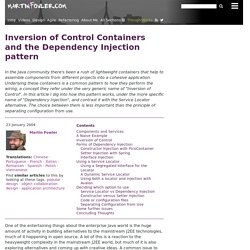
Underlying these containers is a common pattern to how they perform the wiring, a concept they refer under the very generic name of "Inversion of Control". In this article I dig into how this pattern works, under the more specific name of "Dependency Injection", and contrast it with the Service Locator alternative. The choice between them is less important than the principle of separating configuration from use. One of the entertaining things about the enterprise Java world is the huge amount of activity in building alternatives to the mainstream J2EE technologies, much of it happening in open source. A lot of this is a reaction to the heavyweight complexity in the mainstream J2EE world, but much of it is also exploring alternatives and coming up with creative ideas.
Components and Services A Naive Example class MovieLister... Component or service. Resist the Temptation of the Singleton Pattern. From Programmer 97-things The Singleton pattern solves many of your problems.
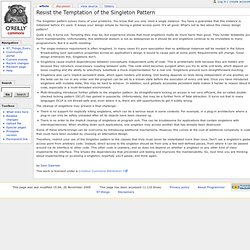
You know that you only need a single instance. You have a guarantee that this instance is initialized before it's used. It keeps your design simple by having a global access point. It's all good. Quite a lot, it turns out. Adapter pattern. Definition[edit] An adapter helps two incompatible interfaces to work together.
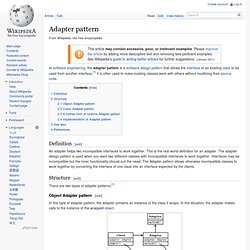
This is the real world definition for an adapter. The adapter design pattern is used when you want two different classes with incompatible interfaces to work together. Interfaces may be incompatible but the inner functionality should suit the need. The Adapter pattern allows otherwise incompatible classes to work together by converting the interface of one class into an interface expected by the clients. Structure[edit] There are two types of adapter patterns:[1] Adapter Design Pattern. Intent Convert the interface of a class into another interface clients expect.
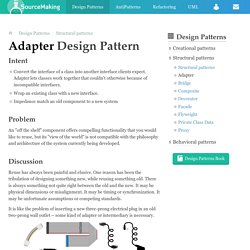
Adapter lets classes work together that couldn't otherwise because of incompatible interfaces.Wrap an existing class with a new interface.Impedance match an old component to a new system Problem An "off the shelf" component offers compelling functionality that you would like to reuse, but its "view of the world" is not compatible with the philosophy and architecture of the system currently being developed. Discussion Reuse has always been painful and elusive. It is like the problem of inserting a new three-prong electrical plug in an old two-prong wall outlet – some kind of adapter or intermediary is necessary. Adapter is about creating an intermediary abstraction that translates, or maps, the old component to the new system.
Design Patterns Uncovered: The Adapter Pattern. Continuing our series of articles, taking each design pattern one by one, we move onto the Adapter pattern.

This pattern is used a lot in Eclipse, allowing plug-ins to be loosely coupled, yet still be integrated into the Eclipse runtime. Adapters in the Real World A real world analogy always helps with the understanding of a design pattern. The best example for the adapter pattern is based around AC power adapters. Say you're visiting Europe from the US, with your laptop, which expects a US power supply. Design Patterns RefcardFor a great overview of the most popular design patterns, DZone's Design Patterns Refcard is the best place to start.
The Adapter Pattern The Adapter is known as a structural pattern, as it's used to identifying a simple way to realize relationships between entities.